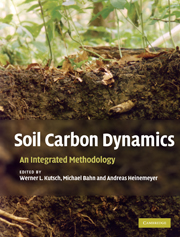Book contents
- Frontmatter
- Contents
- List of Contributors
- Preface
- Editorial Acknowledgements
- 1 Soil carbon relations: an overview
- 2 Field measurements of soil respiration: principles and constraints, potentials and limitations of different methods
- 3 Experimental design: scaling up in time and space, and its statistical considerations
- 4 Determination of soil carbon stocks and changes
- 5 Litter decomposition: concepts, methods and future perspectives
- 6 Characterization of soil organic matter
- 7 Respiration from roots and the mycorrhizosphere
- 8 Separating autotrophic and heterotrophic components of soil respiration: lessons learned from trenching and related root-exclusion experiments
- 9 Measuring soil microbial parameters relevant for soil carbon fluxes
- 10 Trophic interactions and their implications for soil carbon fluxes
- 11 Semi-empirical modelling of the response of soil respiration to environmental factors in laboratory and field conditions
- 12 Modelling soil carbon dynamics
- 13 The role of soils in the Kyoto Protocol
- 14 Synthesis: emerging issues and challenges for an integrated understanding of soil carbon fluxes
- 15 Appendix: Towards a standardized protocol for the measurement of soil CO2 efflux
- Index
- References
6 - Characterization of soil organic matter
Published online by Cambridge University Press: 11 May 2010
- Frontmatter
- Contents
- List of Contributors
- Preface
- Editorial Acknowledgements
- 1 Soil carbon relations: an overview
- 2 Field measurements of soil respiration: principles and constraints, potentials and limitations of different methods
- 3 Experimental design: scaling up in time and space, and its statistical considerations
- 4 Determination of soil carbon stocks and changes
- 5 Litter decomposition: concepts, methods and future perspectives
- 6 Characterization of soil organic matter
- 7 Respiration from roots and the mycorrhizosphere
- 8 Separating autotrophic and heterotrophic components of soil respiration: lessons learned from trenching and related root-exclusion experiments
- 9 Measuring soil microbial parameters relevant for soil carbon fluxes
- 10 Trophic interactions and their implications for soil carbon fluxes
- 11 Semi-empirical modelling of the response of soil respiration to environmental factors in laboratory and field conditions
- 12 Modelling soil carbon dynamics
- 13 The role of soils in the Kyoto Protocol
- 14 Synthesis: emerging issues and challenges for an integrated understanding of soil carbon fluxes
- 15 Appendix: Towards a standardized protocol for the measurement of soil CO2 efflux
- Index
- References
Summary
INTRODUCTION
Soil organic matter (SOM) generally refers to the non-living organic material within the soil matrix that was once part of, or produced by, a living organism. It is usually determined on soil that has passed through a 2-mm sieve, and therefore is free of coarse animal residues, surface litter and large roots. Soil organic matter can be of plant, animal or microbial origin, and consists of a continuum of materials in various stages of alteration due to both biotic and abiotic processes (Baldock and Skjemstad, 2000). Methods used in the past to estimate directly SOM content involved the destruction of the organic matter by treatment with hydrogen peroxide (H2O2) or by ignition of the soil at high temperature (Nelson and Sommers, 1996). Both of these techniques, however, are subject to significant error: oxidation of SOM by H2O2 is incomplete, and some inorganic soil constituents decompose upon heating.
While different elements such as C, N, P, S etc. are bound into organic compounds, we will concentrate on soil organic carbon (SOC) for the purposes of this chapter because it is the dominant element, and because of its role in the global carbon cycle. Organic carbon to SOM conversion factors for surface soils typically range from 1.72 to 2.0 g SOM g−1 C (Nelson and Sommers, 1996). Direct measurement of total soil carbon involves the conversion of all forms of carbon to carbon dioxide (CO2) by wet or dry combustion and subsequent quantification of the evolved CO2.
- Type
- Chapter
- Information
- Soil Carbon DynamicsAn Integrated Methodology, pp. 91 - 126Publisher: Cambridge University PressPrint publication year: 2010
References
- 10
- Cited by

